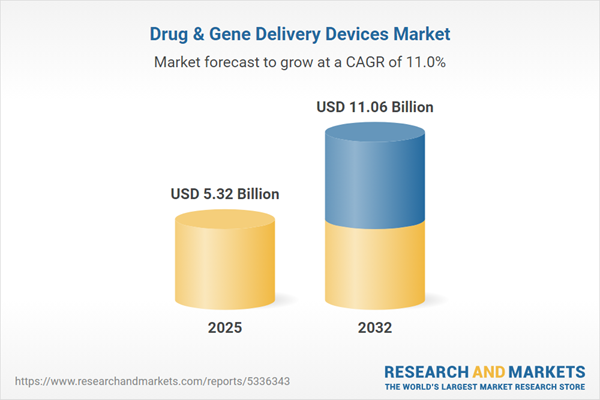Speak directly to the analyst to clarify any post sales queries you may have.
The drug and gene delivery devices market is evolving rapidly as senior healthcare leaders seek advanced, device-driven solutions to support precision care, operational efficiency, and better health outcomes.
Market Snapshot: Drug & Gene Delivery Devices Market
In 2024, the global drug and gene delivery devices market is valued at USD 4.79 billion, driven by an anticipated compound annual growth rate (CAGR) of 11.03% until 2032, with projections reaching USD 11.06 billion. This dynamic expansion is underscored by widespread integration of advanced delivery technologies across care environments, including hospitals, clinics, diagnostic labs, and home settings. Enhanced biocompatibility and engineering innovations are reshaping medication administration, enabling more precise, patient-tailored treatments. As pharmaceutical compounds and biological agents advance, healthcare organizations are aligning treatment pathways to increase therapeutic efficacy and adapt to the needs of diverse patient groups.
Scope & Segmentation: Comprehensive Breakdown
- Technologies: Hydrogel constructs, nanoparticle formulations, polymer matrices, and liposomal systems all contribute to controlled, targeted drug delivery. These technologies support steady therapeutic performance and improved stability of compounds throughout varied treatment phases.
- Device Types: Auto injectors, infusion pumps, pen injectors, needle-free systems, and new syringe platforms streamline medication administration. Integration of digital health features broadens application, facilitating both clinical and home-based self-care.
- Molecule Types: Monoclonal antibodies, peptides, gene therapies, and recombinant proteins remain key categories. Utilizing both viral and non-viral delivery methods, organizations can respond quickly to evolving medical demands.
- End Users: Hospitals, clinics, research facilities, and home care agencies implement these devices for diagnosis, ongoing monitoring, and workflow integration, with platforms customized to complex clinical requirements.
- Applications: Smart delivery systems, controlled-release products, implantable devices, and targeted solutions reinforce adherence, reduce adverse events, and adapt to varied care regimens.
- Therapeutic Areas: Cardiovascular disease, diabetes, oncology, and infectious diseases see significant device usage for both acute and chronic patient management, reflecting the need for scalable interventions.
- Geographic Regions: The Americas, Europe, Middle East and Africa, and Asia-Pacific all show strong potential. North America and Europe benefit from established healthcare frameworks, while Asia-Pacific experiences rapid growth influenced by regulatory agility and investments, notably in China, India, Japan, and Australia.
- Key Companies: Becton Dickinson and Company, West Pharmaceutical Services, Terumo Corporation, Gerresheimer AG, Baxter International, Nipro Corporation, Stevanato Group, SHL Medical AG, Ypsomed Holding AG, and Lonza Group AG are actively progressing product innovation and shaping the competitive landscape.
Key Takeaways: Strategic Insights for Senior Decision-Makers
- Intelligent and connected drug delivery devices empower healthcare providers to adopt patient-centric, data-driven models for oversight and clinical decision-making.
- Strengthened collaboration among device manufacturers, pharmaceutical companies, and digital health partners enables the growth of integrated care ecosystems and enhances strategic responses to market changes.
- Focus on user-oriented product design advances usability, ensuring consistency in treatment protocols and supporting delivery in centralized institutions or distributed, home-centered care settings.
- Adoption of innovative biomaterials and advanced tracking features supports compliance, optimizes resource use, and accelerates device deployment across varied healthcare scenarios.
- Streamlined supply chain processes allow for improved operational resilience and effective implementation of new technologies within changing regulatory environments.
Tariff Impact: Navigating Policy-Driven Shifts in 2025
- Adjustments in U.S. import tariffs prompt organizations to focus on domestic and regional supply chains, supporting continuity and reducing dependence on global logistics.
- Onshore and nearshore manufacturing initiatives promote faster innovation cycles, improved regulatory alignment, and rapid response to trade shifts across core segments.
- Advances in material science, especially in non-viral delivery methods, enhance raw material access and support secure supply chains for emerging therapeutics.
- Structured logistics and forward-looking contingency plans foster stable pricing and uninterrupted device delivery in shifting policy environments.
Methodology & Data Sources
This analysis synthesizes perspectives from more than fifty specialists spanning clinical, engineering, procurement, and regulatory disciplines. Proprietary intelligence, public sources, and regulatory datasets underpin the findings, ensuring actionable guidance tailored for business decision-makers.
Why This Report Matters
- Presents senior leaders with targeted segmentation and practical guidance for navigating an evolving, highly competitive market.
- Arms stakeholders with strategic perspective for investment and partnership planning, addressing anticipated regulatory and technological changes in major markets.
- Supports effective collaboration with payers and advocates, strengthening organizational alignment and reinforcing robust market positioning.
Conclusion
By applying these insights, executives maintain an informed, agile approach as technological advancements and regulatory shifts redefine the drug and gene delivery devices market.
Additional Product Information:
- Purchase of this report includes 1 year online access with quarterly updates.
- This report can be updated on request. Please contact our Customer Experience team using the Ask a Question widget on our website.
Table of Contents
3. Executive Summary
4. Market Overview
7. Cumulative Impact of Artificial Intelligence 2025
Companies Mentioned
The companies profiled in this Drug & Gene Delivery Devices market report include:- Becton Dickinson and Company
- West Pharmaceutical Services, Inc.
- Terumo Corporation
- Gerresheimer AG
- Baxter International Inc.
- Nipro Corporation
- Stevanato Group S.p.A.
- SHL Medical AG
- Ypsomed Holding AG
- Lonza Group AG
Table Information
| Report Attribute | Details |
|---|---|
| No. of Pages | 182 |
| Published | November 2025 |
| Forecast Period | 2025 - 2032 |
| Estimated Market Value ( USD | $ 5.32 Billion |
| Forecasted Market Value ( USD | $ 11.06 Billion |
| Compound Annual Growth Rate | 11.0% |
| Regions Covered | Global |
| No. of Companies Mentioned | 11 |









